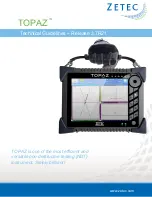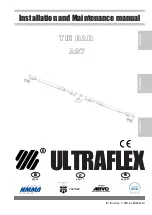
AMBE-2000™ Vocoder Chip Users Manual
Version 4.92, June, 08
DVSI Confidential Proprietary, Subject to Change
Page 9
Visit us at
www.dvsinc.com
2 AMBE-2020™ Application Design Overview
2.1
Basic Operation
In its simplest model, the AMBE-2020™ can be viewed as two separate components, the Encoder and the Decoder. The
Encoder receives an 8kHz sampled stream of speech data (16-bit linear, 8-bit Alaw, or 8-bit ulaw) and outputs a stream of
channel data at the desired rate. Conversely the Decoder receives a stream of channel data and synthesizes a stream of speech
data. The timing for the interfaces for the AMBE-2020™ Encoder and Decoder are fully asynchronous.
Figure 2-A Basic Operation
AMBE-2020
Encoder
8kHz Speech Data
AMBE-2020
Decoder
8kHz Speech Data
Compressed Data @ 2000-9600bps
Typically the speech interface is an external A/D-D/A chip. The format of the incoming and outgoing speech data streams are
coupled, that is to say they must be the same format (16-bit linear, 8-bit Alaw, or 8-bit
µ
law). The channel interface is
commonly (but not limited to) an 8 or 16 bit microprocessor or other suitable ‘glue logic’ hardware capable of performing the
rudimentary formatting functions between the AMBE-2020™ channel format and the format of the system channel.
Optional functions of the chip, such as voice activation/detection, power mode control, data/FEC rate selection, etc. are
controlled either through hardware control pins (see Section 5) and/or through the decoder command interface (see Section 4)
Data sent into the decoder for function control purposes is distinguished from the data to be decoded into speech through a
channel format which is described in Section 4.
2.2
Initial Design Considerations
Some of the initial design considerations the application engineer will face are the following:
•
Choice of A/D-D/A chip.
•
Choice of Channel Interface.
•
Speech and FEC Rates.
2.2.1
A/D – D/A Overview
The choice of the A/D-D/A chip is critical to designing a system with superior voice quality. Given that Alaw and
µ
law
companding chips are already incorporating some compression to reduce the number of bits per sample, it is recommended
that, when possible, a 16-bit linear device be used for maximum voice quality. When choosing a device, pay particular
attention to Signal to Noise ratios and Frequency Responses of any filters that may be present on the analog front end of these
chips. The Alaw and
µ
law interfaces are also provided for the design engineer who is trying to fit to pre-existing conditions or
is under other cost type restraints.









































